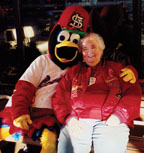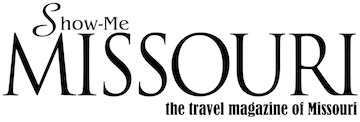
For more than 10 years, Kristen Lokemen was a staff writer and travel specialist for Show-Me Missouri. Over the summer of 2001 she assisted in conducting a tour of the Lewis and Clark Trail from Missouri to the Oregon coast and subsequently penned an 11-part series that ran through the bicentennial observance of the expedition's kickoff. She would eventually lead numerous other tours along that same path, sharing her enthusiasm with hundreds of travelers.
Sadly, Kris died on May 26, 2018. Of all the stories that Kris wrote for Show-Me Missouri, none stand out more than her series on Lewis and Clark's Corps of Discovery. Over the next two weeks, we will run the series in its entirety.
Corps of Discovery: A Carrot Of Tobacoo
There was never truly an easy day for Meriwether Lewis, William Clark and the other men who comprised the Corps of Discovery. There was nothing easy about tugging heavily loaded boats upstream against the current, constantly battling the elements, including the always loathsome mosquitoes. Still, the first months of the Lewis and Clark Expedition had gone well. The captains and their men enjoyed the new country through which they were traveling, and their initial encounters with native tribes had been peaceful and positive.
It was now early September and the Corps had entered the High Plains and what is now northern Nebraska. Here Lewis and Clark encountered a small, chattering animal. Sgt. John Ordway wrote in his journal on September 7, 1804, “Shields killed a prarie dog, which was cooked for the Capts dinner. The Captains went out with Some men of the party to See the Ground covered with their holes. They attempted to drown Several of them out of their holes, but they caught but one which was brought in alive. They are a curious animal about the Size of a little dog. They will stand on their hind feet and look and chatter.”
A matter of growing concern as they headed into the country of the Teton Sioux was the prolonged absence of Pvt. George Shannon. The youngest member of the Corps had been missing since August 26, when he had gone out hunting. John Colter and George Drouillard were sent to search for him, but were unsuccessful. Aside from their worries for Shannon, himself, the captains knew that they would need every man armed and ready when they met the Sioux.
Somehow Shannon had gotten ahead of the boats, spending 16 days chasing what was behind him. By September 11, when he was found sitting on the riverbank, the young soldier was half-starved. He had run out of bullets after the first few days and had survived on one rabbit and a lot of grapes and plums. William Clark found it hard to believe that “a man had like to have Starved to death in a land of Plenty for the want of Bulletes or Something to kill his meat.”
On these beautiful September days, Meriwether Lewis enjoyed walking on shore and viewing “the interior of the country.” His journal descriptions of this time wee particularly descriptive, but then they stopped. From September 17, 1804 to April 1805, there are no entries. Historians are unsure if Lewis simply stopped writing or if that part of his journal was lost.
The Teton Sioux
The inevitable meeting with the Teton Sioux finally came about on September 23, when three teenage boys swam across the river to check out the white men’s camp. As the Corps was preparing to leave the next morning, Colter’s horse was stolen by members of the tribe. The captains reacted with some degree of anger, telling the five braves that they had come in peace, but were not afraid to fight.
That afternoon the keelboat and pirogues docked near what is now Pierre, South Dakota. The men were put on full alert, with most of the party kept aboard the boats in case a hasty getaway became necessary.
The council with the Teton Sioux was held on the morning of September 25, aided by the interpreting efforts of Cruzatte, who had been convinced to join the expedition after it had already headed up the Missouri.
As had been the case with the Oto and Yankton Sioux, the Tetons were greatly disappointed in what they were given by the white men, and they were much more vocal about it. The demanded one of the pirogues loaded with goods in return for allowing the expedition to continue upriver. One of the chiefs became especially belligerent and angered Clark enough that he drew his sword and ordered the men to arms.
Lewis was on the keelboat, where the men laded musket balls into the swivel gun, put up the breastworks and made ready to fight. Lewis held a lighted taper over the swivel gun, as hundreds of Indians faced him from the bank, including three braves holding onto the keelboat’s towline. Another Indian hugged the mast.
It was one of those moments on which history turns. Had the standoff ended in violence, the progression of westward expansion might well have been very different. Black Buffalo, the head Teton chief, was the first to act, telling his braves to let go of the boat. Clark, however, was furious with what he considered personal insults from another chief, known as the Partisan.
Black Buffalo and two of his warriors asked to spend the night on the keelboat. They were given permission and, at least for the moment, tensions ebbed.
The next day the Corps of Discovery visited the lodge of Black Buffalo. A dance was held in the Indian camp that night as a way to entertain the captains and their crew. The Sioux’s scalp dance celebrated their recent victory over the Omaha tribe. They had taken many women and children as prisoners.
As Clark was returning to the keelboat after a second night of dancing, the pirogue he was in swung wildly and severed the keelboat’s anchor. Clark shouted for hands to help. The Partisan thought that the Omaha were attacking, and soon the bank was lined with two hundred warriors. Lewis, on shore, feared the Indians were about to attack, but finally, the Indians realized what had really happened, and another tense moment passed without a shot being fired.
The expedition prepared to continue upriver the next day, but the Teton Sioux were still reluctant to let them pass without receiving more presents. Warriors again held the bowline of the keelboat and angry words were exchanged. Black Buffalo asked for more tobacco, and Lewis refused on principle. The situation escalated to the point that Clark lit the taper for the swivel gun and threatened to use it. To defuse the situation and get his party moving again, Lewis finally threw a few carrots of tobacco onto the riverbank. The Sioux let go of the keelboat’s towline, and the Corps of Discovery proceeded on.
While Lewis and Clark had managed to avoid armed conflict with the Teton Sioux, it was clear that the meeting had not gone well. What that would mean for other Americans coming upriver or for the expedition when it came back downriver was a cause for some concern.
With the Sioux behind them, the Corps of Discovery settled into beautiful fall days on the river. The weather had cooled, early frosts had killed off the mosquitoes, and hunting was good. Lewis and his dog, Seaman, would sometimes walk 30 miles a day, as the captain investigated the new terrain and the wildlife that it held. He also passed many abandoned Indian villages, once home to the Arikara, whose numbers had been decimated by smallpox.
Where the Arikara still lived, Lewis and Clark visited with the chiefs and persuaded one of them to travel upriver with the party to council with the Mandans, with whom the Arikara were at war. They reached the Mandan villages, west of present-day Bismarck, North Dakota, in late October. Here the Corps of Discovery would build a fort and dig in for the winter. Here, during that winter, they would also meet a teenage Indian girl who would later save their lives. Her name was Sakakawe (more commonly known as Sacajawea.)
P.O. Box 53
Kennett, Missouri 63857
Toll-Free: (888) 751-6334
Local: 573-888-1100
Email: info@showmemissouri.net
